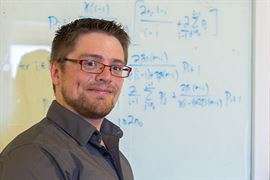 Graduate student Jason Davis doesn’t use a traditional lab to study prion diseases. Instead, he relies on computer modeling and applied mathematics.
Graduate student Jason Davis doesn’t use a traditional lab to study prion diseases. Instead, he relies on computer modeling and applied mathematics.
Working with Suzanne Sindi, a professor of applied mathematics at UC Merced, Davis is trying to unlock the mysteries of prions and the destructive diseases they create. It’s a growing form of interdisciplinary research that uses math to examine biological functions.
“Working in applied math is a great opportunity to see the ‘big ideas’ from across various scientific disciplines,” said Davis, a Ph.D. candidate in applied mathematics. “Few areas of study have such broad application and it is very rewarding to apply my mathematical knowledge to real problems, particularly in health.”
Prion diseases result from proteins that become misshapen or misfolded — often in the brain. These destructive proteins clump together as masses or chains and multiply by converting other healthy proteins into a corrupted form.
Mad cow disease is perhaps the most well-known prion disease. While prion diseases always are fatal in mammals, researchers have found that a protein in yeast can actually reform misfolded proteins and head off infection.
Through his research, Davis is trying to understand why and how that occurs in yeast, and to look for a similar healing thread in humans. To do so, he creates mathematical models of prion diseases and uses a computer to simulate the infection. Such computer modeling is faster and less expensive than traditional lab work, and no animals or organisms are used in the experiments.
Davis’ research could have implications for neurodegenerative diseases such as Alzheimer’s, Parkinson’s and Huntington’s. These crippling and ultimately fatal diseases are all caused by protein misfolding disorders.
Davis took an uncommon route to UC Merced. He grew up in Bridgewater, Maine, a tiny town near the Canadian border where schoolchildren once took a “harvest break” to work on family potato farms. He had an affinity for math and spent most of his high school years at the magnet Maine School of Science and Mathematics in Limestone, Maine.
“That school got me started on my academic trajectory,” said Davis, a first-generation college student. “It made me realize that I could handle academia.”
The demanding curriculum gave Davis a head start at Brown University, where he earned the equivalent of bachelor’s degrees in both mathematics and education studies. Davis then took a job with the Air Force Office of Scientific Research in Arlington, Virginia, where he helped manage research funds in the areas of applied mathematics and computer science. While there, he also earned a master’s in mathematics and statistics from Georgetown University.
Davis might never have headed west without an invitation from Sindi, whom he met and worked with while she was doing postdoctoral work at Brown. Sindi asked him to join her research team at UC Merced, where she had just accepted a job in 2012.
Davis hopes to finish his doctorate in a few years and then work in a national lab or manage research projects. He said he appreciates his time at UC Merced, where the campus’s small size and interdisciplinary approach to research allow him to directly engage with faculty members and find collaborative opportunities.
He’s also happy to have traded the big-city lifestyle for a relaxed pace — although it’s still a step up from his hometown. “Merced is a booming metropolis compared to where I grew up,” he said.
Sindi praised Davis as a hard-working and thoughtful student. In addition to his research work, Davis also has helped mentor other students and aided in recruitment efforts.
“He’s a very energetic, positive guy,” she said. “He has contributed a lot to the program.”